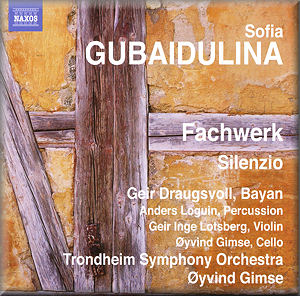 |
 |
|


alternatively
CD: MDT
AmazonUK
AmazonUS
Sound
Samples & Downloads |
Sofia GUBAIDULINA (b.1931)
Fachwerk (2009/2011) [36:16]*
Silenzio (1991) [19:38]**
 Geir Draugsvoll (bayan), Anders Loguin (percussion), Geir Inge Lotsberg
(violin), Řyvind Gimse (cello)
Geir Draugsvoll (bayan), Anders Loguin (percussion), Geir Inge Lotsberg
(violin), Řyvind Gimse (cello)
Trondheim Symphony Orchestra Strings/Řyvind Gimse
rec. 28 February-4 March 2011, Kolstad Church, Trondheim, Norway.
DDD
 NAXOS 8.572772 [55:55]
NAXOS 8.572772 [55:55] 
|
|
|
The music of Sofia Gubaidulina, who was born 80 years ago last month (October 2011), is generally exciting, often unpredictable, always fresh. The two pieces on this new CD have all those qualities. They make it one you should certainly get if you're even only remotely interested in her music; or if you want to include novelty and experiment in your listening - particularly to explore the ways in which instruments' particular qualities can be made successfully to convey certain ideas, meet specific compositional aims and evoke specific feelings.
Not that the world premičre recording in the case of Fachwerk - which was only completed this year - is in any way avant-garde in the conventional sense of the term. It's tonal, developmental melodically, and uses an all but 'regular' string orchestra. Yet the inclusion of the bayan, a distinctively Russian variant of the accordion offers new, subtle and delightful sounds to the listener with open ears.
It would be wrong to suggest that for Gubaidulina texture is everything in this piece. On the other hand, the lush and harmonious, fruity and penetrating combination of sounds from the bayan makes for an intriguing experience. It's a combination of sounds that sits well mid-way between the traditional, almost militaristic, one that evokes Cossack dancing and anything more 'benign'. Yet Gubaidulina does not attempt oddity in sound for oddity's sake. There is purpose and beauty in Fachwerk. It is at times menacing - as towards the end of the piece's 36+ minutes and there are hints of unfinished business - of matters unresolved - throughout yet there is much contrasting gentleness.
It is possible to listen to Fachwerk, which means 'timber framing' without any notion of the allusions with which Gubaidulina is working. Yet to understand that she has buildings so constructed in mind undoubtedly adds a significant dimension. They are buildings where the superstructure is exposed, where nothing is hidden. Indeed, to have succeeded as well as Gubaidulina has in Fachwerk and to expose correspondingly the very 'construction' of the instruments is a remarkable achievement. But it's somehow what the composer has done. The music is geometrical without being sterile. It’s muscular and strong without being monolithic. It is transparent without its sounds dominating the subtle aesthetic. Gubaidulina's intention goes some way towards explaining her choice of the bayan: it can easily alternate between melodic and chordal writing. To have achieved the same thing with a string orchestra and still to have provided purely musical interest for the entire duration is a real feat. Gubaidulina explains in the as usual adequate notes how she uses the dominant, subdominant and tonic. This takes nothing away: there is still nothing mechanical or formulaic in Fachwerk.
Similarly, the five movements of Silenzio, whose titles are distinguished by the designation of a different crotchet value as a metronome marking (from the crotchet = 42 as the second to crotchet = 152 as the fourth) have nothing of the spuriously showy, 'uppity' or ostentatious about them. At the same time the work is full of energy and taut in the extreme. The combination of bayan, violin and cello is as novel as it is successful. Gubaidulina somehow does portray silence. The music seems at all times content to sway and gesture, to hint and diminish.
Less than half the length of Fachwerk, Silenzio nevertheless covers much ground. Its intimacy magically suggests a vaster purview. Equally magically it draws us into it - in large part because the three soloists see no need to overstate the case for a gentle, relaxed and closely nuanced - yet highly expressive - dynamic throughout. Although marked pianissimo, one has the feeling that even were these three players to ignore that, Silenzio would have as much impact as it here does: it is a substantial piece.
The CD has a dry and concentrated acoustic. Oddly, this helps our appreciation of the intensity and drive of Gubaidulina's music - even with the need for respectful resonance from the bayan. Furthermore, no one instrument is overbearing or too penetrating, for all the inciting and pointed roles they are asked to play. This is due as much to the skill of the performers as anything. Their first duty is to the unperfumed yet delicate world which Gubaidulina creates and then deftly occupies. They discharge such a duty very well.
Mark Sealey
See also review
by Rob Barnett
|
|

